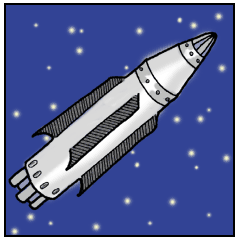
Temperatures of Outer Space
[20 Minutes]
The space shuttle is most likely the most complex and technological machine in the world. The shuttle was the first type of spacecraft to be able to be used on more than one mission. The very first spacecraft were designed to be used only once. Many of their parts burned up as they reentered the atmosphere or left in space. The space shuttle encounters extremes temperatures while in orbit, and as it re-enters the atmosphere its surface is raised to exceptionally high temperatures. It is covered with protective black tiles that can withstand heat up to 1100 degrees centigrade or 2012 Fahrenheit! Try this experiment to learn about how insulation works.
You'll need:
• paper • pencil • 2 to 4 rubber bands • 2 thermometers • 2 empty soda cans • 2 small, clear, clean glass jars • hot water • clay (just enough to cover the openings in the cans) • paper towels • paper bag • aluminum foil
What to do:
- If possible, print out these directions. Read them through before you begin.
- Gather everything you'll need and always remember science safety.
- You will be using the paper towel, the paper bag, and the aluminum foil to wrap around one of the cans. Cut three pieces that will fit all the way around the can.
- Layer the three pieces in the following way. The paper towel is on the outside; the foil is in the middle; and the paper bag is on the inside.
- Run tap water until it gets hot. Fill both cans with the water.
- The key to this experiment is to have a helper and to work quickly before the water cools. Ask your helper to make two small clay balls about the size of a quarter.
- Quickly press the clay over the hole in the can. Be certain that the clay does not go into the hole.
- With your helper, wrap the layered paper around one of the cans. You can secure it with the elastic bands.
- Leave the other can unwrapped.
- Let the cans sit for 30-40 minutes.
- Check to make sure both thermometers register the same temperature. If the temperatures are different, run the thermometers under warm water to get them to register the same temperature.
- After the 30-40 minutes, pour the water out of the cans into each glass jar. Leave the wrapper on while you are pouring.
- You may wish to place the can behind the jar it was poured into so as not to confuse them.
- Put a thermometer into each glass jar and let stand for a few minutes.
- Leave the thermometers in the glass jars and take the readings. You may have to press the thermometer to the side of the jar to take the reading.
- Observe what happens.
- Write down your findings.
Useful information:
The water in the wrapped can will be about 3-5 degrees warmer than the water in the unwrapped can. The combination of the paper towel, paper bag, and tin foil act as insulation. Space shuttles encounter extreme areas of heat and cold while traveling in space. The shuttles are covered with protective tiles that protect against such extremes. The tiles help insulate the shuttle, instead of keeping the heat in, they keep the heat out.
|